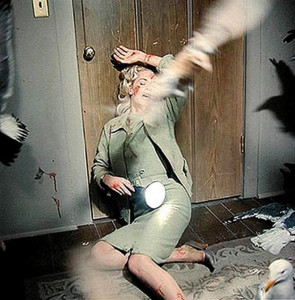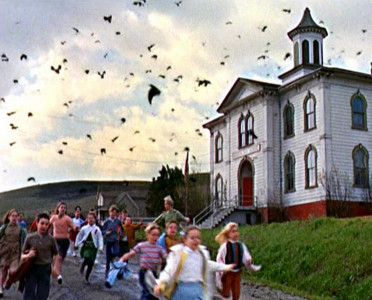One of the seminal horror films and most terrifying movie-going experiences of our time is Alfred Hitchcock’s 1963 “The Birds”. And what better time to talk about some of its “tricks” and “treats” than Halloween.
Loosely based on the 1952 story “The Birds” by Daphne du Maurier, the film screenplay was written by Evan Hunter. Known for his ability to create tension, not to mention having worked with Hitchcock on the television anthology “Alfred Hitchcock Presents”, Hunter was charged with developing new characters and more intricate plot. Starting with the horrific ideology of unexplained widespread violent bird attacks, together Hitchcock and Hunter delved into underlying psychological complexities addressing guilty secrets of the townspeople, and then allowing the imagination to ponder if the bird attacks are a form of punishment. Hitchcock even drew from real life instances of documented bird “attacks” in August 1961 that had homes attacked during the night and come morning, found the town of Capitola, California littered with dead bird carcasses.
As Evan Hunter noted in his 1997 autobiography, “Me and Hitch”, with the horror elements firmly implanted in their minds, he suggested to Hitchcock the film pull some elements from the screwball comedy genre and then evolve into horror, suspense and ultimately, “stark terror”. Hitchcock loved the idea because of the suspense that would be created as the audience lay in wait, uncertain when the birds would attack.
While Du Maurier’s story was set at an English village on the sea, Hitchcock chose the sleepy little fishing town of Bodega Bay, California for his adaptation and made the most of every location, street, shop and townsperson it offered, imbuing “The Birds”, as with all of his films, chilling reality.
The film debut of Tippi Hedren, and her first time working with Hitchcock, “The Birds” has become the most identifiable role of her career. “The Birds” also stars Rod Taylor, Jessica Tandy, Suzanne Pleshette and Veronica Cartwright. But then there are “The Birds” themselves, marking the first time animals were portrayed by a director on screen with a collective intelligence working together in unison. While we know this is true of many species in nature, to see it so terrifyingly portrayed on the big screen is a testament to Hitchcock and his meld of live birds, trained wild birds, mechanical birds, wild birds on strings and wires and overlay technical enhancements. After six months of principal shooting, it still took almost three years to complete the film before its 1963 release.
So, how about a few fun “Did You Know” facts about “The Birds”. . .
1. The ASPCA was on set the entire film shoot and an aviary was established to treat injured birds.
2. This is the only Hitchcock film to not have the “The End” title card. A calculated move on his part, Hitchcock wanted the audience to feel that the terror would continue.
3. There was an alternate ending to the film that Hitchcock wanted to shoot but was talked out of it by screenwriter Evan Hunter. Hitchcock originally wanted the ending to include a town on fire, another bird attack as Melanie, Mitch, Lydia and Cathy try to get to the car to leave, and then a final wide panoramic shot of the Golden Gate Bridge covered in birds. Hunter told Hitchcock it would take at least a month to film just this shot.
4. As it is, the final shot of the film is composed of three panels, matte paintings and multiple film layers, i.e., 32 separate exposures, leading Hitchcock himself to call this “the most difficult single shot I’ve ever done.” Complex is an understatement as the scene combined live birds, animated birds, mechanical birds and the car driving toward the matte painting backdrop.
5. Cinematographer was Robert Burks. Hitchcock’s favorite lenser, Burks worked with Hitchcock on twelve of Hitchcock’s films. Starting with “Strangers On A Train” and ending with “Marnie”, the only Hitchcock film Burks missed was “Psycho.”
6. One may think that Tippi Hedren is “acting” in the key attic scene. This was no acting. This was true terror. Assured by Hitchcock personally that mechanical birds were being used in the attic, on the first take she walked into an attic filled with live birds which were flying loose and also be flung at her by prop men. Over the course of this five day shoot for this one scene, live gulls, ravens and crows were thrown at Hedren until she was ultimately gouged on her cheek near her eye at which point she was hospitalized for a week.
7. Birds were hooked onto Tippi Hedren’s suit with rubber bands looped through fabric and wrapped around actual birds.
8. Early in “The Birds” as Melanie is crossing the bay alone in the little skiff heading back to town, the seagull that attacks her was hooked to a wire while blood plungers were hidden in Hedren’s hair. When the gull was let go down the wire and hits her head, a prop man would hit the plunger of blood.
9. While filming the house attack scenes, the house was netted to keep the birds contained.
10. Hammers with fake bird heads were used to hammer and peck thru the wood doors to give the effect the birds were breaking through.
11. In an attempt to keep the birds from flying off roofs and gutters, production designer Robert Boyle tried putting magnets on the birds’ claws to hold them onto metal gutters. It didn’t work. The birds only flipped upside down when they tried to fly.
12. 371 “trick shots”, as Hitchcock called them, were used in “The Birds”.
13. Again, seeking authenticity and palpable terror, Hitchcock had cinematographer Robert Burks and his camera operators tie meat to cameras to get the seagulls to fly at the camera lens in attack mode.
14. Ray Berwick was head bird trainer on “The Birds”. Berwick later reflected on the experience and admitted that the birds used in the film could never be released or kept as pets because they were trained to attack.
15. There are no scenes in the film of anyone covered in bird droppings.
16. Sound plays a key role in “The Birds” embracing the idea that silence is terrifying and deafening and in much of the film represents the silent calm before the storm of attack.
17. Bird attacks are typically preceded by dialogue addressing loneliness or fear of loneliness or with a visual of a single character shot.
18. Double entendres and tongue-in-cheek black humor is peppered throughout the script with lines like, “Fried chicken and mashed potatoes!” in the background of the diner while the foreground characters are talking about the attacks and just killing all the birds. Another example is the ordering of Bloody Marys as a precursor to the bloodshed coming in an imminent attack.
19. Much of the production design and lensing style of “The Birds” with the ultimate attack on the Brenner house can be seen as a visual influence in M. Knight Shyamalan’s “Signs”.
20. Foregoing traditional score, Hitchcock used synthesized birdcage & flapping bird noises designed as a score by Oskar Sala and Remi Gassmann utilizing Sala’s electroacoustic Mixtur-Trautonium synthesizer.
21. Working with editor George Tomasini, Hitchcock made extensive use of the long, extended pause, creating a chilling ambience as a prelude to when the next attacks would occur.
22. A technical hallmark of “The Birds” is the lensing of the bird attacks. Using a sodium vapor or “yellow screen” process developed by Ub Iwerks at Walt Disney Studios, the process involves a screen lit with narrow-spectrum sodium vapor lights. A scene is filmed concurrently on two different cameras, one using regular film stock, the other a special stock emulsion sensitive only to the sodium vapor wavelength. Meld them together and the effect is seamless and in many cases, more precise and visually authentic than green screen today.

















